Affiliate links on Android Authority may earn us a commission. Learn more.
Snapdragon 8 Gen 1 deep dive: Everything you need to know
Despite the new name, Qualcomm’s Snapdragon 8 Gen 1 is the ninth major annual smartphone platform release in the flagship Snapdragon SoC series. It’s also the 18th model in the 8-series, once you total up all the Plus and other variants. Just to make things more confusing, Qualcomm has also decided to drop numbering from its Adreno GPU, Hexagon DSP, and other assorted parts within the chip.
To mark the name change, the Snapdragon 8 Gen 1 boasts Qualcomm’s first Armv9 CPU cores, a beefed-up 18-bit triple image signal processor (ISP), and better-than-ever machine learning (ML) number-crunching capabilities. All pretty typical improvements, based on previous years, and there are a few smaller changes tucked away inside the SoC too. So let’s get into exactly what’s new and what we can expect from the Snapdragon 8 Gen 1.
Editor’s note: The Snapdragon 8 Gen 1 is no longer the newest and highest-end Qualcomm Snapdragon chip. It has been replaced by the Snapdragon 8 Gen 2.
Snapdragon 8 Gen 1 vs Snapdragon 888 and older chips
| Snapdragon 8 Gen 1 | Snapdragon 888 | Snapdragon 865 | |
|---|---|---|---|
CPU Config | Snapdragon 8 Gen 1 1x 3.0GHz (Cortex-X2) 3x 2.5GHz (Cortex-A710) 4x 1.8GHz (Cortex-A510) | Snapdragon 888 1x 2.84GHz (Cortex-X1) 3x 2.4GHz (Cortex-A78) 4x 1.8GHz (Cortex-A55) | Snapdragon 865 1x 2.84GHz (Cortex-A77) 3x 2.4GHz (Cortex-A77) 4x 1.8GHz (Cortex-A55) |
GPU | Snapdragon 8 Gen 1 Adreno | Snapdragon 888 Adreno 660 | Snapdragon 865 Adreno 650 |
DSP | Snapdragon 8 Gen 1 Hexagon (fused scalar, tensor, and vector) (Mixed precision support) | Snapdragon 888 Hexagon 780 (fused scalar, tensor, and vector) | Snapdragon 865 Hexagon 698 |
RAM support | Snapdragon 8 Gen 1 LPDDR5 @ 3,200MHz | Snapdragon 888 LPDDR5 @ 3,200MHz | Snapdragon 865 LPDDR5 @ 2,750MHz LPDDR4X @ 2,133MHz |
Camera support | Snapdragon 8 Gen 1 • 200MP single shot • 108MP single with zero shutter lag • 64MP+36MP with zero shutter lag • Triple 36MP with zero shutter lag • Hybrid AF • 10-bit HEIF image capture • HDR video • Multi-frame noise reduction • Real-time object classification, segmentation, and replacement • Video super resolution | Snapdragon 888 • 200MP single shot • 84MP single with zero shutter lag • 64MP+25MP with zero shutter lag • Triple 24MP with zero shutter lag • Hybrid AF • 10-bit HEIF image capture • HDR video • Multi-frame noise reduction • Real-time object classification, segmentation, and replacement | Snapdragon 865 • 200MP single shot • 64MP with zero shutter lag • 25MP dual camera with zero shutter lag • Hybrid AF • HDR video • Multi-frame noise reduction • Real-time object classification, segmentation, and replacement |
Video capture | Snapdragon 8 Gen 1 8K @ 30fps (HDR) 4K UHD @ 120fps 720p @ 960fps | Snapdragon 888 8K @ 30fps 4K UHD @ 120fps 720p @ 960fps | Snapdragon 865 8K @ 30fps 4K UHD @ 120fps 720p @ 960fps |
Video playback | Snapdragon 8 Gen 1 8K 4K HDR up to 120fps H.265 and VP9 video decoder 360 degree | Snapdragon 888 8K 4K HDR up to 120fps H.265 and VP9 video decoder 360 degree | Snapdragon 865 8K 4K HDR up to 120fps H.265 and VP9 video decoder 360 degree |
Charging | Snapdragon 8 Gen 1 Quick Charge 5 | Snapdragon 888 Quick Charge 5 | Snapdragon 865 Quick Charge 4+ Quick Charge AI |
4G/5G Modem | Snapdragon 8 Gen 1 X65 LTE/5G (integrated) 10,000Mbps down | Snapdragon 888 X60 LTE/5G (integrated) 7,500Mbps down 3,000Mbps up | Snapdragon 865 X55 LTE/5G (external) 7,500Mbps down 3,000Mbps up |
Other networking | Snapdragon 8 Gen 1 Bluetooth 5.2 Wi-Fi 6E, Wi-Fi 6 (802.11ax), Wi-Fi 5 (802.11ac), 802.11a/b/g/n | Snapdragon 888 Bluetooth 5.2 Wi-Fi 6E, Wi-Fi 6 (802.11ax), Wi-Fi 5 (802.11ac), 802.11a/b/g/n | Snapdragon 865 Bluetooth 5.1 Wi-Fi 6 (802.11ax), Wi-Fi 5 (802.11ac), 802.11a/b/g/n |
Process | Snapdragon 8 Gen 1 4nm | Snapdragon 888 5nm | Snapdragon 865 7nm FinFET |
What’s new with the Snapdragon 8 Gen 1: CPU and graphics
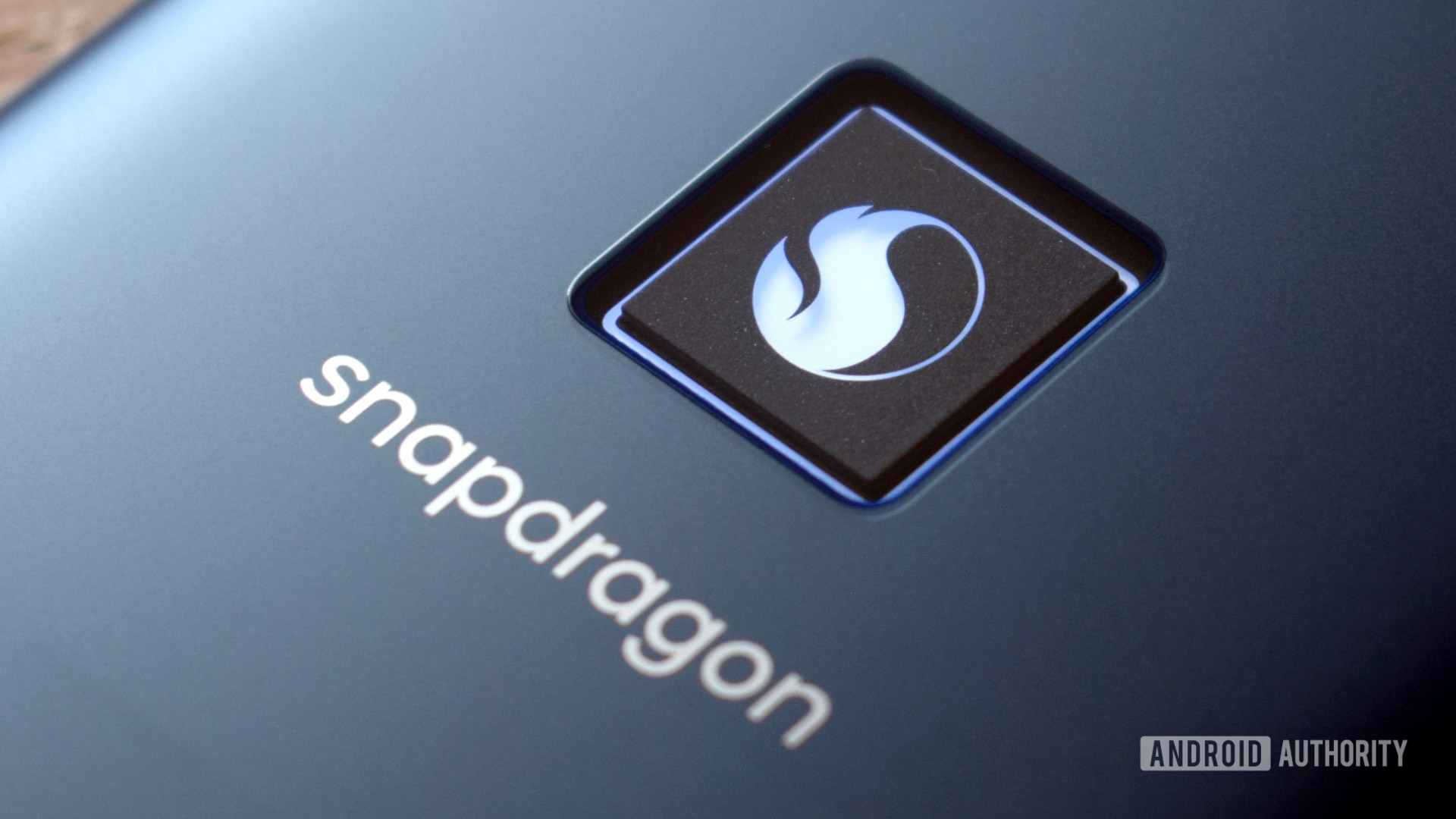
With the announcement of Armv9 CPU cores early in the year, we already had a good idea about what to expect from 2022 flagship processors and smartphones, at least in this regard. The Snapdragon 8 Gen 1 SoC is powered by a single Cortex-X2 powerhouse CPU core clocked at a higher 3GHz than last year, two big Cortex-A710 cores at 2.5GHz, and four energy-efficient Cortex-A510 cores at a more modest 1.8GHz. Qualcomm is sticking with its tried and tested 1+3+4 tri-cluster CPU arrangement, rather than the slightly more experimental 2+2+4 setup in the Google Tensor.
Qualcomm says we’re looking at a 20% performance improvement and 30% power saving compared to the CPU setup inside the previous generation Snapdragon 888. That’s nothing to be sniffed at but the performance is more conservative than Arm’s up to 30% performance gain estimate, once you take into account clock frequency and manufacturing process improvements. Although Qualcomm notes that it optimizes these cores with its own power and other systems, which may explain the bigger efficiency gains, rather than solely peak performance improvement. And to be fair to Qualcomm, better battery life is much more sought-after than raw number-crunching these days.
Qualcomm has paired the Cortex-X2 with 1MB of L2 cache and there’s a 512KB cache for each of the A710 cores. That’s the same cache setup as last year, which perhaps explains the performance target being a little lower than Arm’s maximum claims for the X2. That said, there is a larger 6MB L3 cache, up from 4MB in the previous generation, which will definitely help keeps these new cores fed.
Qualcomm hasn’t given out L2 cache details for the small A510 cores but we do know that Qualcomm is making use of the microarchitecture’s new “merged-core” capabilities, which sees two cores sharing a NEON/SIMD pipeline and L2 cache in this instance. This helps reduce the core’s area footprint and can improve performance in some instances where the cores share a larger cache than they’d have individually. However, Qualcomm won’t divulge the cache size, leading to the suspicion that the setup might be using a small cache and therefore potentially sacrificing some performance over a traditional per-core cache layout.
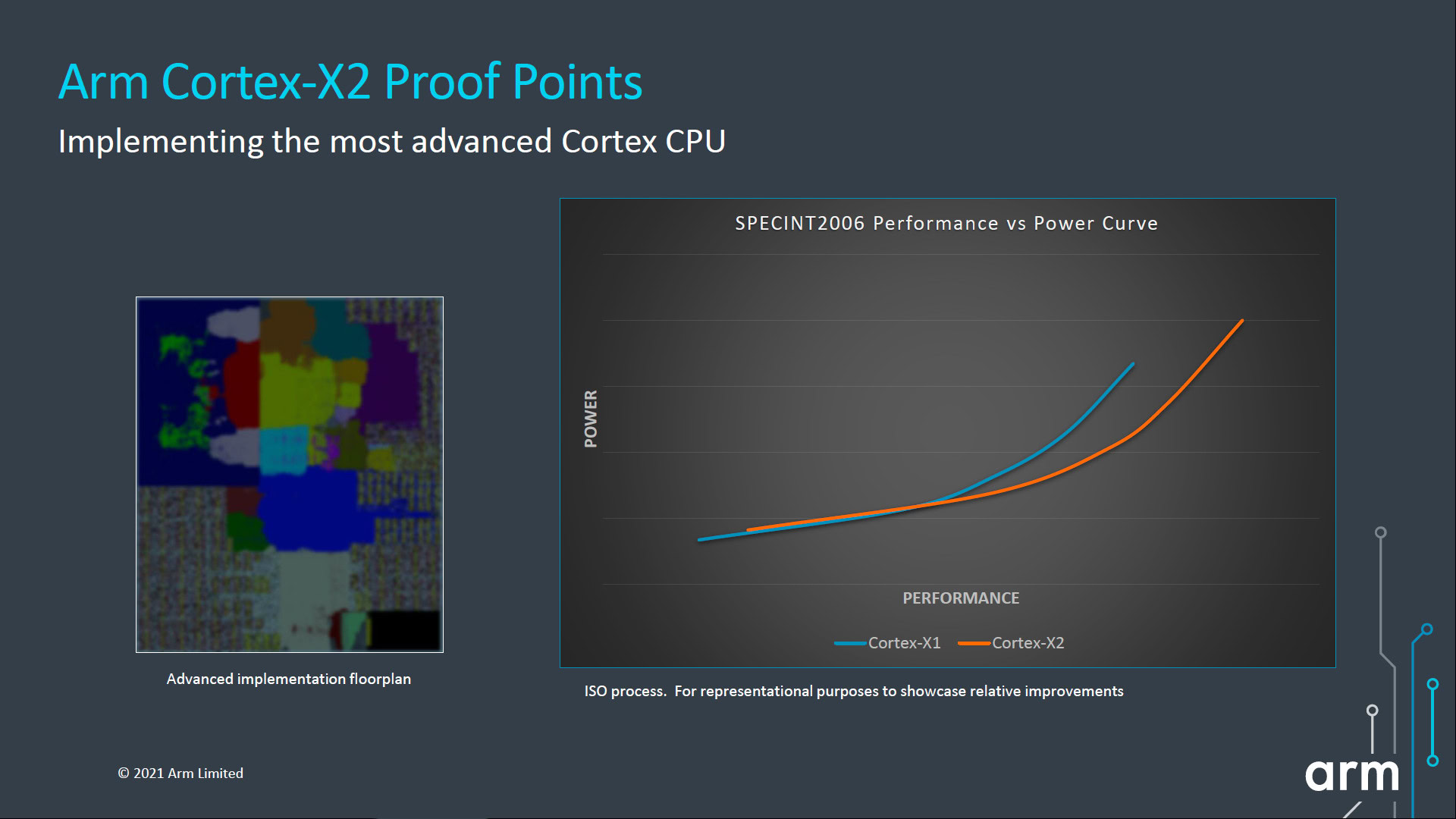
When it comes to graphics, the Snapdragon 8 Gen 1 includes an unnumbered in-house Adreno GPU. Performance-wise, Qualcomm boasts an impressive 30% performance boost over its previous generation SoC and an equally newsworthy 25% power saving. Performance gains hit up to 60% when using the Vulkan API, although this might be more of a fix for previously less-than-ideal performance rather than a complete game-changer for mobile gaming frame rates, and could be a big win for some emulators. Again, this helps close the gap on Apple silicon but certainly won’t leapfrog it.
Snapdragon Elite Gaming features stick around from the previous year and the Snapdragon 8 Gen 1 incorporates three new ones. There’s the new Adreno Frame Motion engine that can double the frame rate without using any additional power or keep the same frame while reducing power consumption. It’s essentially a frame-interpolation implementation running directly on the GPU. We’ve seen similar MEMC frame smoothing ideas implemented in external display processors in other phones.
20% CPU and 30% GPU gains are a familiar cadence for Qualcomm.
The latest Adreno core also supports “desktop-level” volumetric rendering for fancier graphics. There’s also VRS Pro, which integrates image-based frame processing into its variable-rate shading solution for notable performance and power consumption savings. There’s no ray tracing here if you’d been expecting something outlandish like that — the latest Adreno is still very much a mobile-oriented graphics component.
Performance improvements sound great on paper, but they come at the cost of higher energy consumption in high-performance scenarios. Silicon vendors have been pushing smartphone power budgets to the absolute maximum with recent chipsets.
Snapdragon 8 Gen 1 features: Better photography and machine learning
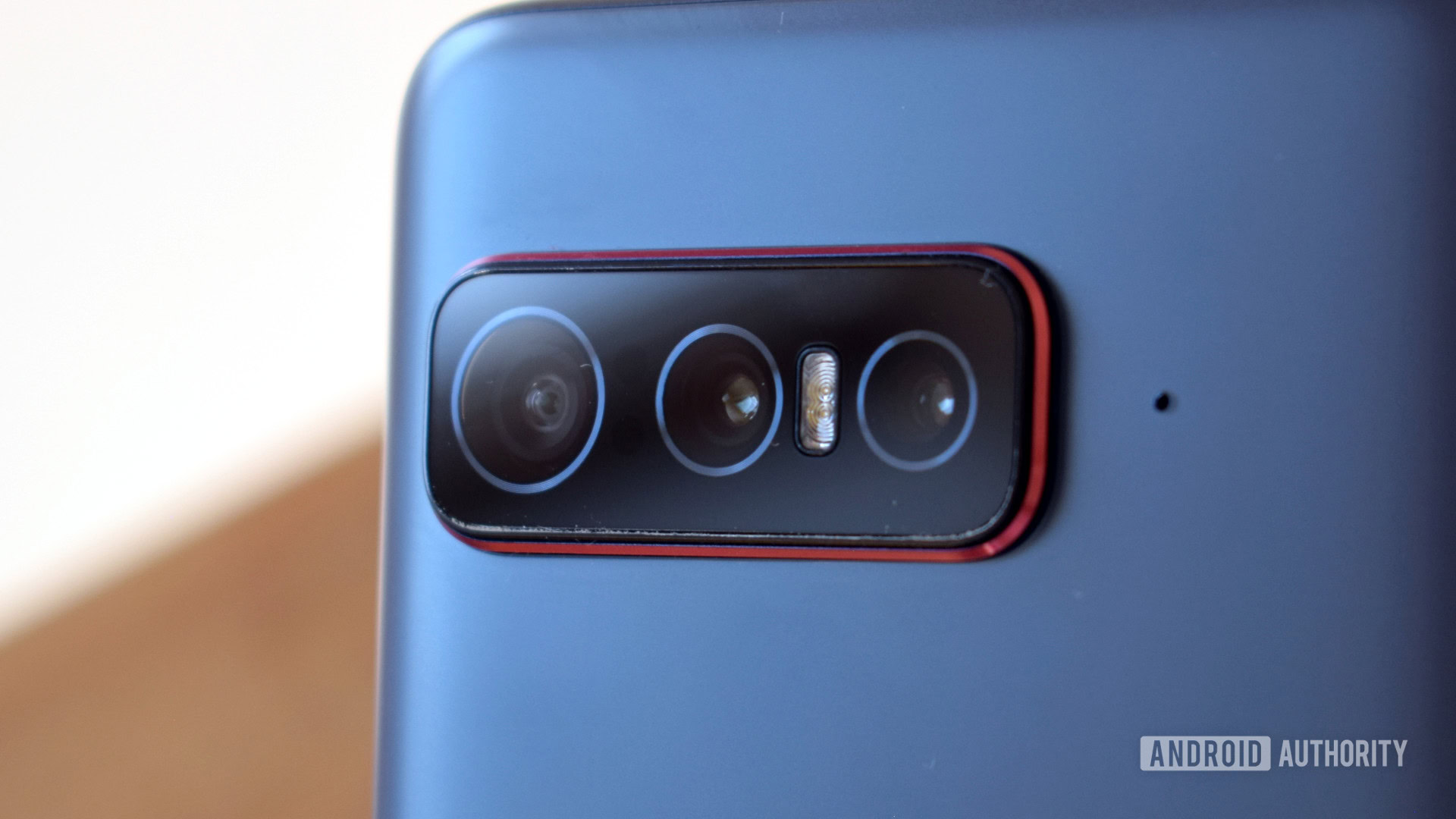
I’m sure you’re aware by now that image processing and machine learning are equally key parts of Qualcomm’s modern chipsets, as they are for virtually every other SoC vendor these days. This heterogeneous-led approach results in a number of other upgrades this generation, the most notable of which comes to the ISP.
Last generation’s triple ISP layout remains and has been upgraded from a 14-bit to 18-bit imaging pipeline and supports 18-bit RAW image output. This results in 3.2 gigapixels of imaging crunching capabilities per second, up from 2.7 last-gen. This more powerful setup allows the Snapdragon 8 Gen 1 to shoot 108MP images with zero shutter lag or pair three 36MP cameras for 30fps capture with zero shutter lag. While video capture is mostly the same as last-gen, 8K 30fps HDR makes an appearance for the first time here.
Qualcomm's 18-bit ISP boasts improved dynamic range but phone image sensors may prove to be the bottleneck.
This extra bandwidth can also be put towards improved HDR image capture. If you’re a photography buff, 18-bits of data equals 18 stops of dynamic range, or 262,144 different possible brightness levels, compared to “just” 16,384 levels with a 14-bit/14 stops ISP. However, bit-depth is just part of the HDR photography picture, and achieving this in the real world depends on noise — a consistent problem for small smartphone image sensors. In reality, it seems doubtful that any mobile camera will fully leverage the 18-bits of dynamic range on offer here.
Qualcomm has a few other imaging tricks embedded into its latest flagship processor. There’s a dedicated bokeh engine to apply soft blur to 4K video, improved AI based-face detection capabilities that can identify up to 300 facial landmarks, an ultra-wide engine to handle de-warp and chromatic aberration correction, video super-resolution, and capabilities to use up to 30 frames instead of six in multi-frame HDR and low light capture. All of these features are offered to Qualcomm’s partners under its new Snapdragon Sight branding.
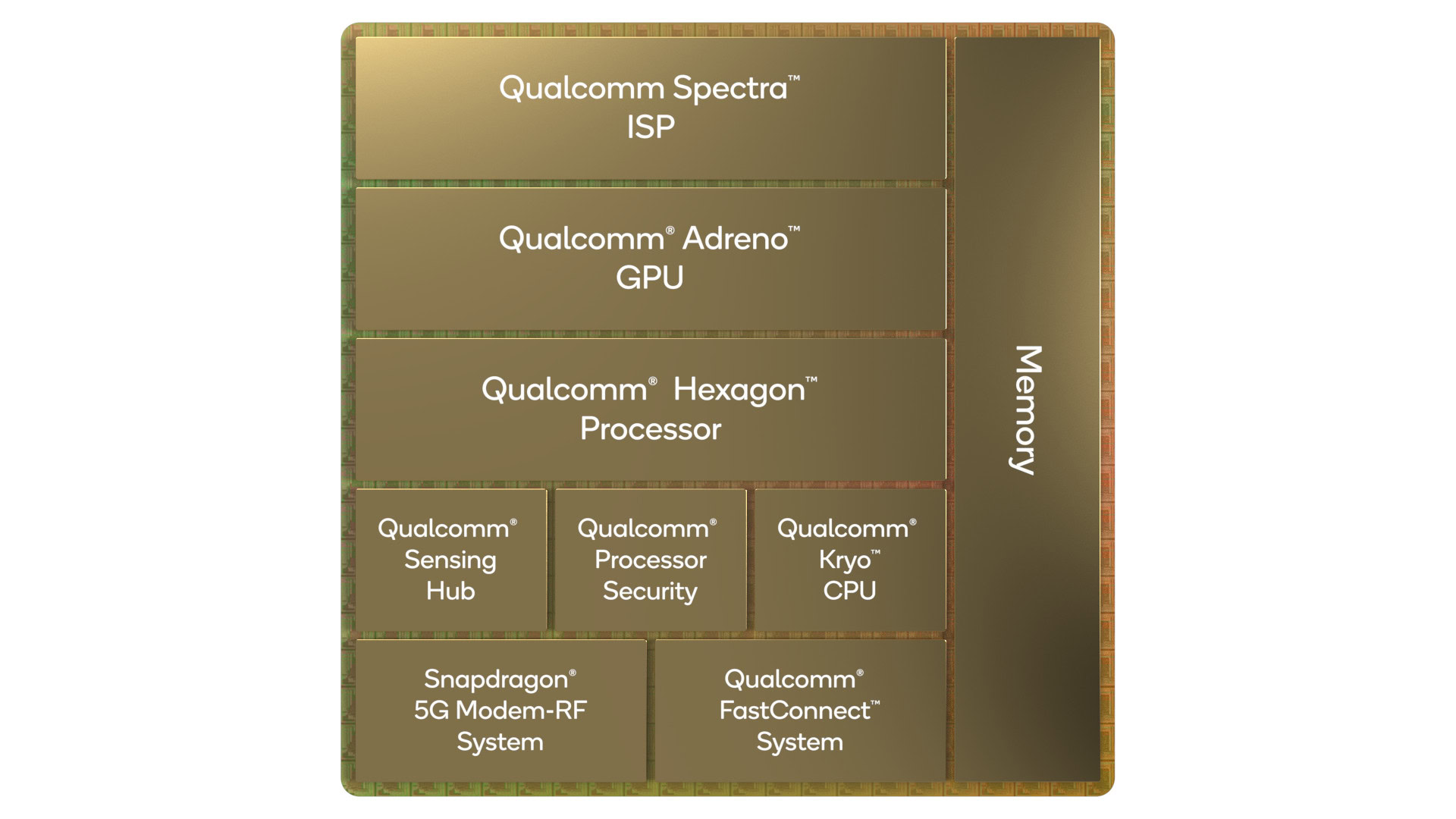
On the machine learning side, Qualcomm has doubled the tensor acceleration performance inside its latest Hexagon DSP thanks, in part, to double the shared system memory on the chip. This means that certain works that rely on tensor operations will run faster than before, Qualcomm’s subsystem is also now up to 1.7x more power-efficient in some workloads.
The Snapdragon 8 Gen 1 is an even more powerful AI and imaging beast but not all OEMs leverage its capabilities.
The Snapdragon 8 Gen 1 augments its ML capabilities further with support for mixed int8 and int16 precision calculations as part of the software SDK. As a result, Qualcomm states that some workloads may see up to a 4x increase in performance through the combination of hardware and software improvements. Hexagon is just one part of the Snapdragon 8 Gen 1’s 7th gen AI Engine. The 3rd gen Sensing Hub now includes a dedicated ISP of its own that supports up to VGA resolution sensors. This is tasked with running always-on facial detection tasks while ensuring low power consumption. However, it’s not used for security authorization, so think of it as handy for detecting when to fire up face unlock and assisting with screen-peeking prevention.
Qualcomm’s latest ISP and ML improvements are a continuation of the formula we’ve come to know over many years. There are some very welcome additions here, particularly in the photography department, but it remains to be seen how far the company’s partners actually go in leveraging the capabilities of the Snapdragon 8 Gen 1.
Other odds and ends

It wouldn’t be a Snapdragon release without a few more new features tucked away somewhere, and the Snapdragon 8 Gen 1 has a few important ones.
For starters, Qualcomm has introduced a new security level into its chipset that sits under the hypervisor layer that runs the Android OS and various other secure services. This all-new Trust Management Engine is built to keep low-level data secure even if higher levels of the software stack are compromised. Qualcomm says it meets the requirements for iSIM and Android Ready SE — a first for the company. Building on Google’s work with its Titan M security module and StrongBox, the Android Ready SE Alliance creates and sets requirements for a range of hardware-backed security applets using secure enclave environments. Future Snapdragon 8 Gen 1 devices could double up as your car keys, digital wallet, driver’s license, and other forms of identification.
With Android Ready SE, future Snapdragon smartphones may be used to securely house your digital car keys, ID, and more.
As we’ve come to expect from Qualcomm’s Fast Connect 6900 wireless subsystem, there’s Bluetooth 5.2 and Wi-Fi 6E support onboard, although the marginally more modern Bluetooth 5.3 is absent. More excitingly for audiophiles, there’s aptX Lossless with bit-exact CD-quality audio as part of the aptX Lossless and Snapdragon Sound audio suite. The chipset also supports the revamped core Bluetooth LE Audio specification. Now you just need a pair of headphones that leverages either technology.
Turning to 5G, the integrated Snapdragon x65 5G modem boasts theoretically faster download speeds of 10Gbps on mmWave networks. Sounds quick, but you won’t see those speeds in the real world and you could argue that the Snapdragon X60’s 7Gbps was already perfectly fast enough. The more important change is the 50% increase in sub-6GHz bandwidth, from 200MHz to 300MHz, allowing for broader use of carrier aggregation techniques in the coming years. That’s good news for download speeds and ensures a robust connection. Likewise, mmWave bandwidth jumps from 800MHz to 1,000MHz, hence the large jump in theoretical peak speeds. The X65 modem also supports the n259 mmWave band, as well as global n70 and n53 sub-6GHz bands.
Bottom line: The Snapdragon 8 Gen 1 is a little bit more future-proof for the more advanced 5G networks that will eventually hit the markets in the coming years, though you may well have upgraded your phone by the time they’re available in your area anyway.
What about the Snapdragon 8 Plus Gen 1?

In May 2022, Qualcomm announced the Snapdragon 8 Plus Gen 1 — a mid-year refresh of its flagship SoC. The company has switched foundries for the refreshed SoC, opting for TSMC’s 4nm manufacturing process for the first time in years. According to Qualcomm, this single change has yielded a 30% efficiency improvement for the CPU and GPU. It also allowed the company to bump clock speeds by 10%. In benchmarks, we found the Snapdragon 8 Gen 1 handily surpasses its predecessor.
In the real world, the Snapdragon 8 Plus Gen 1 should offer better battery life than its predecessor. Qualcomm’s estimates suggest that you’ll be able to squeeze an extra hour of medium-to-heavy usage and several more hours of talk time or music playback.
Smartphones powered by the Snapdragon 8 Plus Gen 1 include the Samsung Galaxy Z Fold 4 and Flip 4, Zenfone 9, OnePlus 10T, and ROG Phone 6.
Snapdragon 8 Gen 1 vs MediaTek Dimensity 9000 and Exynos 2200
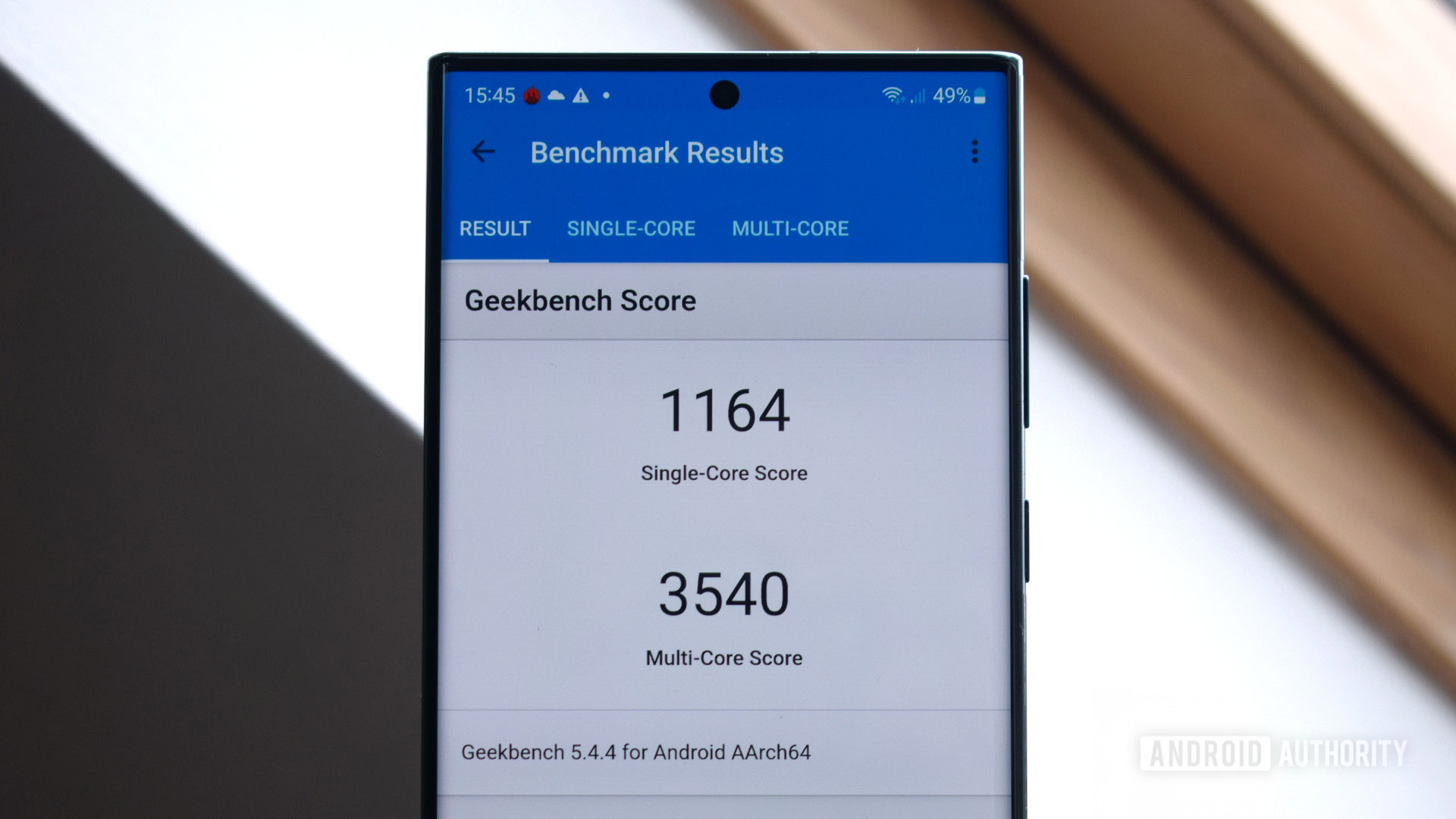
The Snapdragon 8 Gen 1 represents Qualcomm’s latest and greatest, but it isn’t the only high-end Android chip of 2022. It goes up against the MediaTek Dimensity 9000 and the Samsung Exynos 2200. All three chipsets utilize the same ArmV9 CPU cores mentioned previously but differ slightly in terms of their tuning, feature set, and real-world parameters like power consumption.
The Exynos and Snapdragon chips are both manufactured on Samsung’s 4nm process node, while the Dimensity 9000 uses TSMC’s node. The latter’s supposedly better efficiency may have allowed MediaTek to push clock speeds over the competition, netting the Dimensity a slight lead over its direct competitors. There are other subtle differences too, like slightly slower 5G speeds on the MediaTek chip, but the average user likely won’t notice them. The refreshed Snapdragon 8 Plus Gen 1 is a much closer match for the Dimensity 9000 as Qualcomm has also moved to TSMC’s 4nm node.
As for comparing the Snapdragon 8 Gen 1 to the Exynos 2200, our own testing found that the two chips trade blows in CPU-oriented benchmarks. In mixed and GPU workloads, the Snapdragon 8 Gen 1 came out slightly ahead but the difference wasn’t necessarily stark. And despite showcasing better GPU performance, the Snapdragon wasn’t able to sustain it for as long as the Exynos 2200.
All in all, it’s hard to pick a winner between the three chips this generation. Choosing between the best flagship Android SoC in 2022 will depend on your use-cases and preferred workloads.
Which smartphones include the Snapdragon 8 Gen 1?
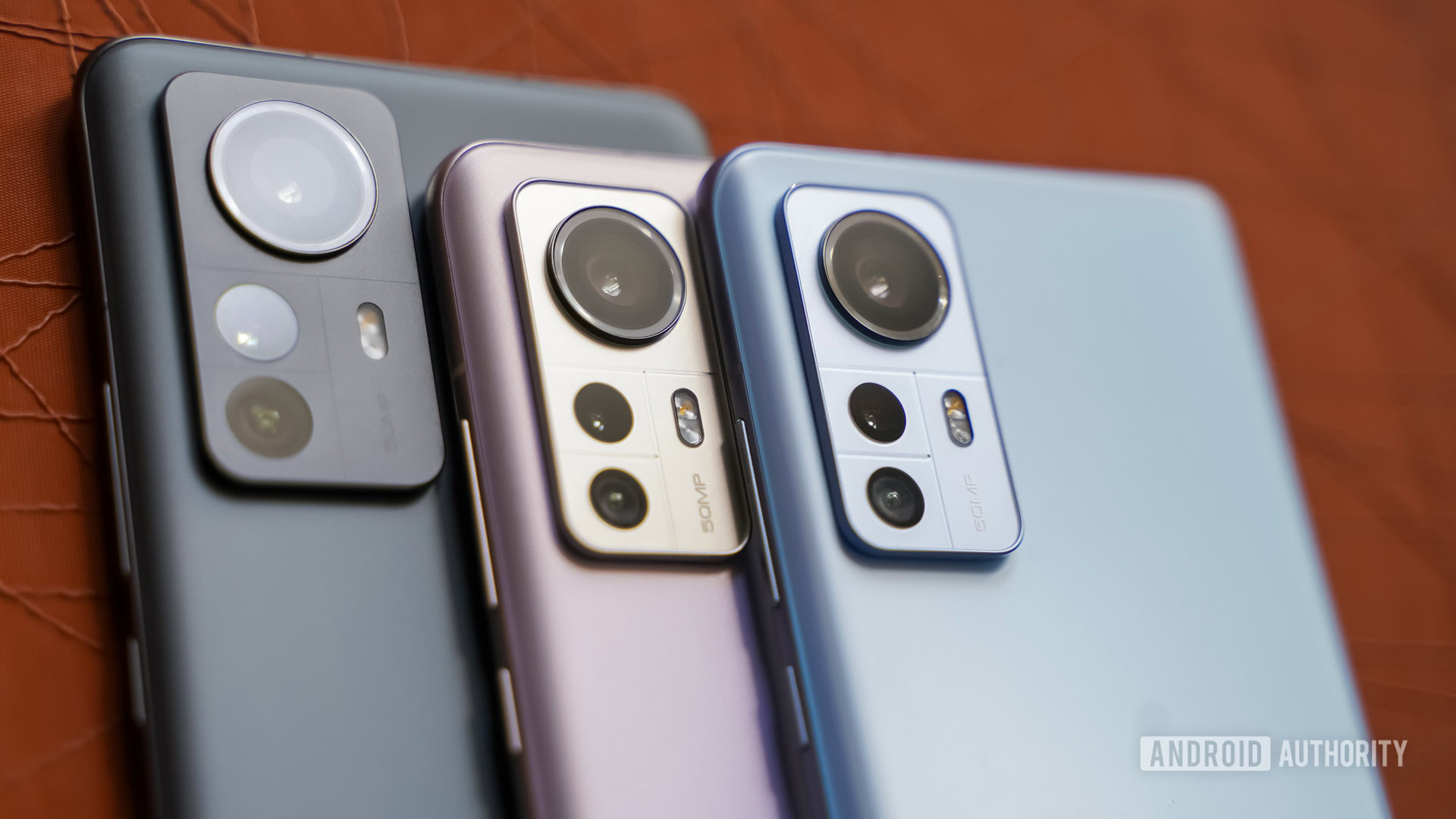
Most major smartphone manufacturers released devices powered by the Snapdragon 8 Gen 1 in 2022. Going forward, we’re likely to see the chipset adopted in budget, sub-flagship smartphones in 2023 and beyond. Having said that, some brands may favor the refreshed Snapdragon 8 Plus Gen 1 going forward. Nevertheless, here’s a quick list of the devices you can buy today:
Should you buy a Snapdragon 8 Gen 1 smartphone?
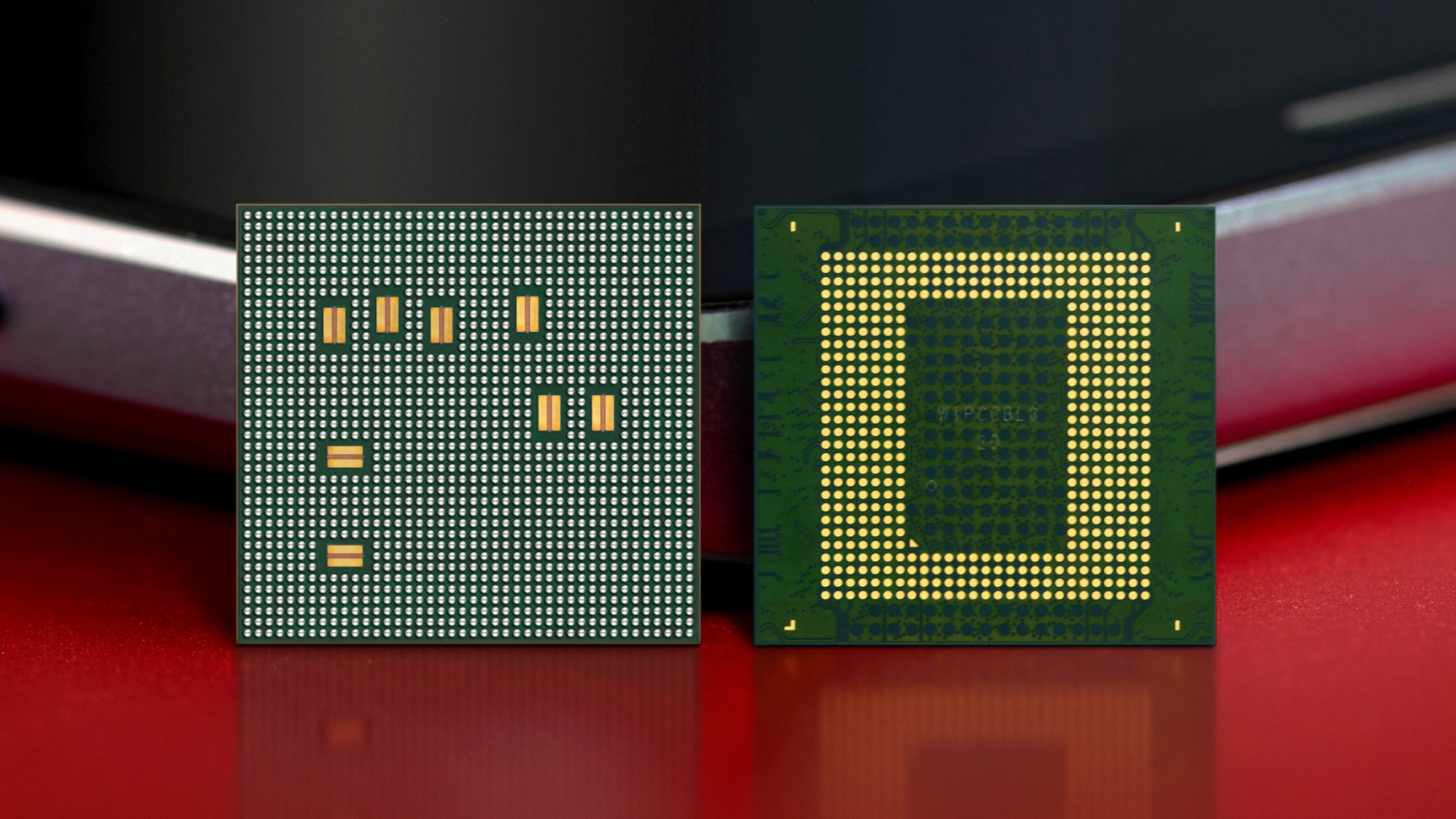
Despite the name change, the Snapdragon 8 Gen 1 looks and feels very familiar to last year and arguably the year before that. Holding pattern might be a little harsh, but if you’re running a current-gen Snapdragon 888 smartphone, you probably won’t feel too much pressure to run out and grab one of the Snapdragon 8 Gen 1 phones.
There are, of course, the usual assortment of performance benefits that certainly add up for mobile gamers looking for ever higher frame rates. A 20% CPU and 30% GPU boost is significant, however, the chip is still likely to end up some ways behind the latest iPhone’s Apple A15 Bionic when it comes to benchmarking. Of course, Qualcomm is awaiting the efforts of its $1.4 billion Nuvia acquisition to bear fruit, with higher-performing CPU designs that might close the gap with Apple in both the mobile and desktop computing arenas.
The Snapdragon 8 Gen 1 is as feature-packed as ever but it's not a quantum leap forward.
Then there’s the AI, imaging, ML, 5G, and security improvements. Again, these are unlikely to fundamentally change the smartphone paradigm and are dependent on smartphone manufacturers making the most of them. Still, the chipset pushes the boundaries that little bit further, allowing for even more use cases than last year, particularly when it comes to photography and the potential of Android Ready SE.
If you’re shopping for a new smartphone, consider the latest Snapdragon 8 Gen 2 chip instead. Besides the expected better performance, it also delivers excellent power efficiency, beating most Qualcomm chips released over the past few years. Most 2023 flagship Android smartphones, including the Galaxy S23 Ultra, feature the Snapdragon 8 Gen 2. You might still find the older chip powering cheaper and lower-end devices.